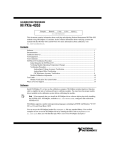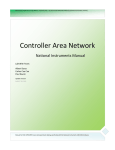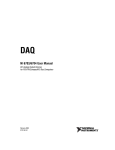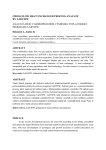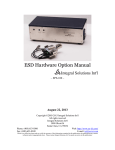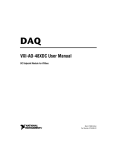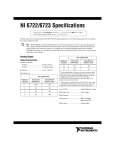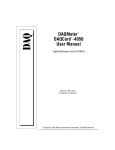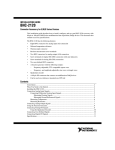Download NI 6703/6704 User Manual
Transcript
DAQ NI 6703/6704 User Manual DC Analog Output Devices for PCI/PXI/CompactPCI Bus Computers NI 6703/6704 User Manual February 2009 372110D-01 Support Worldwide Technical Support and Product Information ni.com National Instruments Corporate Headquarters 11500 North Mopac Expressway Austin, Texas 78759-3504 USA Tel: 512 683 0100 Worldwide Offices Australia 1800 300 800, Austria 43 662 457990-0, Belgium 32 (0) 2 757 0020, Brazil 55 11 3262 3599, Canada 800 433 3488, China 86 21 5050 9800, Czech Republic 420 224 235 774, Denmark 45 45 76 26 00, Finland 358 (0) 9 725 72511, France 01 57 66 24 24, Germany 49 89 7413130, India 91 80 41190000, Israel 972 3 6393737, Italy 39 02 41309277, Japan 0120-527196, Korea 82 02 3451 3400, Lebanon 961 (0) 1 33 28 28, Malaysia 1800 887710, Mexico 01 800 010 0793, Netherlands 31 (0) 348 433 466, New Zealand 0800 553 322, Norway 47 (0) 66 90 76 60, Poland 48 22 328 90 10, Portugal 351 210 311 210, Russia 7 495 783 6851, Singapore 1800 226 5886, Slovenia 386 3 425 42 00, South Africa 27 0 11 805 8197, Spain 34 91 640 0085, Sweden 46 (0) 8 587 895 00, Switzerland 41 56 2005151, Taiwan 886 02 2377 2222, Thailand 662 278 6777, Turkey 90 212 279 3031, United Kingdom 44 (0) 1635 523545 For further support information, refer to the Technical Support and Professional Services appendix. To comment on National Instruments documentation, refer to the National Instruments Web site at ni.com/info and enter the info code feedback. © 1998–2009 National Instruments Corporation. All rights reserved. Important Information Warranty The NI PCI-6703/6704 and NI PXI-6704 are warranted against defects in materials and workmanship for a period of one year from the date of shipment, as evidenced by receipts or other documentation. National Instruments will, at its option, repair or replace equipment that proves to be defective during the warranty period. This warranty includes parts and labor. The media on which you receive National Instruments software are warranted not to fail to execute programming instructions, due to defects in materials and workmanship, for a period of 90 days from date of shipment, as evidenced by receipts or other documentation. National Instruments will, at its option, repair or replace software media that do not execute programming instructions if National Instruments receives notice of such defects during the warranty period. National Instruments does not warrant that the operation of the software shall be uninterrupted or error free. A Return Material Authorization (RMA) number must be obtained from the factory and clearly marked on the outside of the package before any equipment will be accepted for warranty work. National Instruments will pay the shipping costs of returning to the owner parts which are covered by warranty. National Instruments believes that the information in this document is accurate. The document has been carefully reviewed for technical accuracy. In the event that technical or typographical errors exist, National Instruments reserves the right to make changes to subsequent editions of this document without prior notice to holders of this edition. The reader should consult National Instruments if errors are suspected. In no event shall National Instruments be liable for any damages arising out of or related to this document or the information contained in it. EXCEPT AS SPECIFIED HEREIN, NATIONAL INSTRUMENTS MAKES NO WARRANTIES, EXPRESS OR IMPLIED, AND SPECIFICALLY DISCLAIMS ANY WARRANTY OF MERCHANTABILITY OR FITNESS FOR A PARTICULAR PURPOSE. CUSTOMER’S RIGHT TO RECOVER DAMAGES CAUSED BY FAULT OR NEGLIGENCE ON THE PART OF NATIONAL INSTRUMENTS SHALL BE LIMITED TO THE AMOUNT THERETOFORE PAID BY THE CUSTOMER. NATIONAL INSTRUMENTS WILL NOT BE LIABLE FOR DAMAGES RESULTING FROM LOSS OF DATA, PROFITS, USE OF PRODUCTS, OR INCIDENTAL OR CONSEQUENTIAL DAMAGES, EVEN IF ADVISED OF THE POSSIBILITY THEREOF. This limitation of the liability of National Instruments will apply regardless of the form of action, whether in contract or tort, including negligence. Any action against National Instruments must be brought within one year after the cause of action accrues. National Instruments shall not be liable for any delay in performance due to causes beyond its reasonable control. The warranty provided herein does not cover damages, defects, malfunctions, or service failures caused by owner’s failure to follow the National Instruments installation, operation, or maintenance instructions; owner’s modification of the product; owner’s abuse, misuse, or negligent acts; and power failure or surges, fire, flood, accident, actions of third parties, or other events outside reasonable control. Copyright Under the copyright laws, this publication may not be reproduced or transmitted in any form, electronic or mechanical, including photocopying, recording, storing in an information retrieval system, or translating, in whole or in part, without the prior written consent of National Instruments Corporation. Trademarks National Instruments, NI, ni.com, and LabVIEW are trademarks of National Instruments Corporation. Refer to the Terms of Use section on ni.com/legal for more information about National Instruments trademarks. Other product and company names mentioned herein are trademarks or trade names of their respective companies. Members of the National Instruments Alliance Partner Program are business entities independent from National Instruments and have no agency, partnership, or joint-venture relationship with National Instruments. Patents For patents covering National Instruments products/technology, refer to the appropriate location: Help»Patents in your software, the patents.txt file on your media, or the National Instruments Patent Notice at ni.com/patents. WARNING REGARDING USE OF NATIONAL INSTRUMENTS PRODUCTS (1) NATIONAL INSTRUMENTS PRODUCTS ARE NOT DESIGNED WITH COMPONENTS AND TESTING FOR A LEVEL OF RELIABILITY SUITABLE FOR USE IN OR IN CONNECTION WITH SURGICAL IMPLANTS OR AS CRITICAL COMPONENTS IN ANY LIFE SUPPORT SYSTEMS WHOSE FAILURE TO PERFORM CAN REASONABLY BE EXPECTED TO CAUSE SIGNIFICANT INJURY TO A HUMAN. (2) IN ANY APPLICATION, INCLUDING THE ABOVE, RELIABILITY OF OPERATION OF THE SOFTWARE PRODUCTS CAN BE IMPAIRED BY ADVERSE FACTORS, INCLUDING BUT NOT LIMITED TO FLUCTUATIONS IN ELECTRICAL POWER SUPPLY, COMPUTER HARDWARE MALFUNCTIONS, COMPUTER OPERATING SYSTEM SOFTWARE FITNESS, FITNESS OF COMPILERS AND DEVELOPMENT SOFTWARE USED TO DEVELOP AN APPLICATION, INSTALLATION ERRORS, SOFTWARE AND HARDWARE COMPATIBILITY PROBLEMS, MALFUNCTIONS OR FAILURES OF ELECTRONIC MONITORING OR CONTROL DEVICES, TRANSIENT FAILURES OF ELECTRONIC SYSTEMS (HARDWARE AND/OR SOFTWARE), UNANTICIPATED USES OR MISUSES, OR ERRORS ON THE PART OF THE USER OR APPLICATIONS DESIGNER (ADVERSE FACTORS SUCH AS THESE ARE HEREAFTER COLLECTIVELY TERMED “SYSTEM FAILURES”). ANY APPLICATION WHERE A SYSTEM FAILURE WOULD CREATE A RISK OF HARM TO PROPERTY OR PERSONS (INCLUDING THE RISK OF BODILY INJURY AND DEATH) SHOULD NOT BE RELIANT SOLELY UPON ONE FORM OF ELECTRONIC SYSTEM DUE TO THE RISK OF SYSTEM FAILURE. TO AVOID DAMAGE, INJURY, OR DEATH, THE USER OR APPLICATION DESIGNER MUST TAKE REASONABLY PRUDENT STEPS TO PROTECT AGAINST SYSTEM FAILURES, INCLUDING BUT NOT LIMITED TO BACK-UP OR SHUT DOWN MECHANISMS. BECAUSE EACH END-USER SYSTEM IS CUSTOMIZED AND DIFFERS FROM NATIONAL INSTRUMENTS' TESTING PLATFORMS AND BECAUSE A USER OR APPLICATION DESIGNER MAY USE NATIONAL INSTRUMENTS PRODUCTS IN COMBINATION WITH OTHER PRODUCTS IN A MANNER NOT EVALUATED OR CONTEMPLATED BY NATIONAL INSTRUMENTS, THE USER OR APPLICATION DESIGNER IS ULTIMATELY RESPONSIBLE FOR VERIFYING AND VALIDATING THE SUITABILITY OF NATIONAL INSTRUMENTS PRODUCTS WHENEVER NATIONAL INSTRUMENTS PRODUCTS ARE INCORPORATED IN A SYSTEM OR APPLICATION, INCLUDING, WITHOUT LIMITATION, THE APPROPRIATE DESIGN, PROCESS AND SAFETY LEVEL OF SUCH SYSTEM OR APPLICATION. Contents About This Manual Conventions ...................................................................................................................vii Related Documentation..................................................................................................viii Chapter 1 Introduction About the NI 6703/6704 ................................................................................................1-1 Using PXI with CompactPCI.........................................................................................1-2 What You Need to Get Started ......................................................................................1-2 Optional Equipment .......................................................................................................1-3 Custom Cabling ...............................................................................................1-3 Chapter 2 Signal Connections I/O Connector Pin Assignments ....................................................................................2-1 Signal Connection Descriptions ......................................................................2-4 Analog Output Signal Connections ...............................................................................2-5 Voltage Output ................................................................................................2-5 Power-On State .................................................................................2-5 NI 6704 Current Output...................................................................................2-6 Power-on State ..................................................................................2-7 Digital I/O Signal Connections......................................................................................2-7 Power-on State.................................................................................................2-8 Power Connections ........................................................................................................2-8 Chapter 3 Hardware Overview Bus Interface Circuitry...................................................................................................3-2 Flash Memory/DAC Control .........................................................................................3-2 Digital I/O Control.........................................................................................................3-2 Temperature Sensor .......................................................................................................3-2 Chapter 4 Calibration Internal or Self-Calibration ............................................................................................4-1 External Calibration .......................................................................................................4-1 © National Instruments Corporation v NI 6703/6704 User Manual Contents Appendix A Common Questions Appendix B Technical Support and Professional Services Glossary Index NI 6703/6704 User Manual vi ni.com About This Manual This manual contains information about using the NI PCI-6703/6704 and NI PXI-6704 devices. The NI 6703/6704 devices are designed for precise DC setpoint applications and provide general-purpose digital I/O. If you are using NI-DAQ 8.6 or later, refer to the DAQ Getting Started Guide, which you can download at ni.com/manuals. The DAQ Getting Started Guide offers NI-DAQ users step-by-step instructions for installing software and hardware, configuring channels and tasks, and getting started developing an application. Conventions The following conventions appear in this manual: <> Angle brackets that contain numbers separated by an ellipsis represent a range of values associated with a bit or signal name—for example, AO <3..0>. » The » symbol leads you through nested menu items and dialog box options to a final action. The sequence File»Page Setup»Options directs you to pull down the File menu, select the Page Setup item, and select Options from the last dialog box. This icon denotes a note, which alerts you to important information. This icon denotes a caution, which advises you of precautions to take to avoid injury, data loss, or a system crash. When this symbol is marked on a product, refer to the Read Me First: Safety and Radio-Frequency Interference document for information about precautions to take. When symbol is marked on a product, it denotes a warning advising you to take precautions to avoid electrical shock. When symbol is marked on a product, it denotes a component that may be hot. Touching this component may result in bodily injury. bold Bold text denotes items that you must select or click in the software, such as menu items and dialog box options. Bold text also denotes parameter names. © National Instruments Corporation vii NI 6703/6704 User Manual About This Manual italic Italic text denotes variables, emphasis, a cross-reference, or an introduction to a key concept. Italic text also denotes text that is a placeholder for a word or value that you must supply. monospace Text in this font denotes text or characters that you should enter from the keyboard, sections of code, programming examples, and syntax examples. This font is also used for the proper names of disk drives, paths, directories, programs, subprograms, subroutines, device names, functions, operations, variables, filenames, and extensions. NI 6703/6704 This phrase refers to any device in the NI 6703/6704 family. Related Documentation Each application software package and driver includes information about writing applications for taking measurements and controlling measurement devices. The following references to documents assume you have NI-DAQ 8.6 or later, and where applicable, version 7.0 or later of the NI application software. NI-DAQmx for Windows The DAQ Getting Started Guide describes how to install your NI-DAQmx for Windows software, how to install your NI-DAQmx-supported DAQ device, and how to confirm that your device is operating properly. Select Start»All Programs»National Instruments»NI-DAQ»DAQ Getting Started Guide. The NI-DAQ Readme lists which devices are supported by this version of NI-DAQ. Select Start»All Programs»National Instruments»NI-DAQ» NI-DAQ Readme. The NI-DAQmx Help contains general information about measurement concepts, key NI-DAQmx concepts, and common applications that are applicable to all programming environments. Select Start»All Programs» National Instruments»NI-DAQ»NI-DAQmx Help. NI 6703/6704 User Manual viii ni.com About This Manual NI-DAQmx for Linux The DAQ Getting Started Guide describes how to install your NI-DAQmx-supported DAQ device and confirm that your device is operating properly. The NI-DAQ Readme for Linux lists supported devices and includes software installation instructions, frequently asked questions, and known issues. The C Function Reference Help describes functions and attributes. The NI-DAQmx for Linux Configuration Guide provides configuration instructions, templates, and instructions for using test panels. Note All NI-DAQmx documentation for Linux is installed at /usr/local/natinst/ nidaqmx/docs. LabVIEW If you are a new user, use the Getting Started with LabVIEW manual to familiarize yourself with the LabVIEW graphical programming environment and the basic LabVIEW features you use to build data acquisition and instrument control applications. Open the Getting Started with LabVIEW manual by selecting Start»All Programs»National Instruments»LabVIEW»LabVIEW Manuals or by navigating to the labview\manuals directory and opening LV_Getting_Started.pdf. Use the LabVIEW Help, available by selecting Help»Search the LabVIEW Help in LabVIEW, to access information about LabVIEW programming concepts, step-by-step instructions for using LabVIEW, and reference information about LabVIEW VIs, functions, palettes, menus, and tools. Refer to the following locations on the Contents tab of the LabVIEW Help for information about NI-DAQmx: • Getting Started»Getting Started with DAQ—Includes overview information and a tutorial to learn how to take an NI-DAQmx measurement in LabVIEW using the DAQ Assistant. • VI and Function Reference»Measurement I/O VIs and Functions—Describes the LabVIEW NI-DAQmx VIs and properties. • Taking Measurements—Contains the conceptual and how-to information you need to acquire and analyze measurement data in LabVIEW, including common measurements, measurement fundamentals, NI-DAQmx key concepts, and device considerations. © National Instruments Corporation ix NI 6703/6704 User Manual About This Manual LabWindows/CVI The Data Acquisition book of the LabWindows/CVI Help contains measurement concepts for NI-DAQmx. This book also contains Taking an NI-DAQmx Measurement in LabWindows/CVI, which includes step-by-step instructions about creating a measurement task using the DAQ Assistant. In LabWindows™/CVI™, select Help»Contents, then select Using LabWindows/CVI»Data Acquisition. The NI-DAQmx Library book of the LabWindows/CVI Help contains API overviews and function reference for NI-DAQmx. Select Library Reference»NI-DAQmx Library in the LabWindows/CVI Help. Measurement Studio If you program your NI-DAQmx-supported device in Measurement Studio using Visual C++, Visual C#, or Visual Basic .NET, you can interactively create channels and tasks by launching the DAQ Assistant from MAX or from within Visual Studio .NET. You can generate the configuration code based on your task or channel in Measurement Studio. Refer to the DAQ Assistant Help for additional information about generating code. You also can create channels and tasks, and write your own applications in your ADE using the NI-DAQmx API. For help with NI-DAQmx methods and properties, refer to the NI-DAQmx .NET Class Library or the NI-DAQmx Visual C++ Class Library included in the NI Measurement Studio Help. For general help with programming in Measurement Studio, refer to the NI Measurement Studio Help, which is fully integrated with the Microsoft Visual Studio .NET help. To view this help file in Visual Studio. NET, select Measurement Studio» NI Measurement Studio Help. To create an application in Visual C++, Visual C#, or Visual Basic .NET, follow these general steps: NI 6703/6704 User Manual 1. In Visual Studio .NET, select File»New»Project to launch the New Project dialog box. 2. Find the Measurement Studio folder for the language you want to create a program in. 3. Choose a project type. You add DAQ tasks as a part of this step. x ni.com About This Manual ANSI C without NI Application Software The NI-DAQmx Help contains API overviews and general information about measurement concepts. Select Start»All Programs»National Instruments»NI-DAQ»NI-DAQmx Help. The NI-DAQmx C Reference Help describes the NI-DAQmx Library functions, which you can use with National Instruments data acquisition devices to develop instrumentation, acquisition, and control applications. Select Start»All Programs»National Instruments»NI-DAQ» NI-DAQmx C Reference Help. .NET Languages without NI Application Software With the Microsoft .NET Framework version 1.1 or later, you can use NI-DAQmx to create applications using Visual C# and Visual Basic .NET without Measurement Studio. You need Microsoft Visual Studio .NET 2003 or Microsoft Visual Studio 2005 for the API documentation to be installed. The installed documentation contains the NI-DAQmx API overview, measurement tasks and concepts, and function reference. This help is fully integrated into the Visual Studio .NET documentation. To view the NI-DAQmx .NET documentation, go to Start»Programs»National Instruments»NI-DAQ»NI-DAQmx .NET Reference Help. Expand NI Measurement Studio Help»NI Measurement Studio .NET Class Library»Reference to view the function reference. Expand NI Measurement Studio Help»NI Measurement Studio .NET Class Library»Using the Measurement Studio .NET Class Libraries to view conceptual topics for using NI-DAQmx with Visual C# and Visual Basic .NET. To get to the same help topics from within Visual Studio, go to Help» Contents. Select Measurement Studio from the Filtered By drop-down list and follow the previous instructions. Device Documentation The NI 6703/6704 Specifications, available at ni.com/manuals contains detailed hardware specifications for NI 6703/6704 devices. NI 6703/6704 Calibration Procedure for NI-DAQmx, available at ni.com/manuals, contains instructions for calibrating the NI 6703/6704 for PCI/PXI/CompactPCI using NI-DAQmx. © National Instruments Corporation xi NI 6703/6704 User Manual About This Manual NI 6703/6704 Calibration Procedure for Traditional NI-DAQ, available at ni.com/manuals, contains instructions for calibrating the NI 6703 for PCI or NI 6704 for PCI/PXI/CompactPCI using Traditional NI-DAQ (Legacy). The following documents also contain information you may find helpful: • NI Developer Zone tutorial, Field Wiring and Noise Considerations for Analog Signals, located at ni.com/zone • PCI Local Bus Specification Revision 2.2 • PICMG CompactPCI 2.0 R3.0 Core Specification • PXI Specification Revision 2.0, available from www.pxisa.org Documentation for supported devices and accessories, including PDF and help files describing device terminals, specifications, features, and operation are on the NI-DAQmx media that includes Device Documentation. Insert the media, open the Device Documentation directory, and double-click the Device Documents shortcut for your language to find, view, and print device documents. Training Courses If you need more help getting started developing an application with NI products, NI offers training courses. To enroll in a course or obtain a detailed course outline, refer to ni.com/training. Technical Support on the Web For additional support, refer to ni.com/support or zone.ni.com. Note You can download these documents at ni.com/manuals. DAQ specifications and some DAQ manuals are available as PDFs. You must have Adobe Acrobat Reader with Search and Accessibility 5.0.5 or later installed to view the PDFs. Refer to the Adobe Systems Incorporated Web site at www.adobe.com to download Acrobat Reader. Refer to the National Instruments Product Manuals Library at ni.com/manuals for updated documentation resources. NI 6703/6704 User Manual xii ni.com 1 Introduction This chapter describes the NI 6703/6704 devices, lists what you need to get started, describes optional software, equipment, and custom cables, and explains how to unpack your device. For information about installing and configuring your device, refer to the DAQ Getting Started Guide at ni.com/manuals. About the NI 6703/6704 The NI 6703/6704 devices are precise DC setpoint devices for PCI and PXI. The NI 6703 devices have 16 voltage output channels. The NI 6704 devices have 16 voltage output channels and 16 current output channels for a total of 32 analog output channels. The NI 6703/6704 devices have eight digital I/O lines. You can use the NI 6703/6704 devices in a wide variety of DC setpoint and digital I/O applications. With the NI 6703/6704 devices, your PC system can serve as a digital I/O system controller for laboratory testing, production testing, and industrial process monitoring and control. These devices can do the following: • Generate experimental stimuli • Generate analog functions • Connect to a variety of signal types, including: – Electromechanical relays – LEDs – Optically isolated, solid-state relays and I/O module mounting racks – Voltage and current excitation for precision transducers – Current excitation for precision transducers (NI 6704 only) For detailed specifications for the NI 6703/6704 devices, refer to the NI 6703/6704 Specifications, available at ni.com/manuals. © National Instruments Corporation 1-1 NI 6703/6704 User Manual Chapter 1 Introduction Using PXI with CompactPCI The ability to use PXI-compatible products with standard CompactPCI products is an important feature of PXI Specification Revision 2.0. If you use a PXI-compatible plug-in device in a standard CompactPCI chassis, you are unable to use PXI-specific functions, but you can still use the basic plug-in device functions. The CompactPCI specification permits vendors to develop sub-buses that coexist with the basic PCI interface on the CompactPCI bus. Compatible operation is not guaranteed between CompactPCI devices with different sub-buses nor between CompactPCI devices with sub-buses and PXI devices. The standard implementation for CompactPCI does not include these sub-buses. The NI PXI-6704 works in any standard CompactPCI chassis adhering to the PICMG CompactPCI 2.0 R3.0 core specification. What You Need to Get Started To set up and use your NI 6703/6704 device, you will need the following: ❑ One of the following devices: – NI PCI-6703 – NI PCI-6704 – NI PXI-6704 ❑ One of the following software packages and documentation: – NI-DAQ 7.4 or later – LabVIEW for Windows – LabWindows/CVI for Windows – Measurement Studio – ANSI C without NI Application Software – .NET Languages without NI Application Software ❑ PC with a free PCI slot or PXI chassis with a free slot ❑ 68-pin cable (SH68-68-D1) ❑ 68-pin terminal block (SCB-68) NI 6703/6704 User Manual 1-2 ni.com Chapter 1 Introduction Optional Equipment National Instruments offers a variety of products to use with your NI 6703/6704, including cables, connector blocks, and other accessories, as follows: • Cables and cable assemblies, shielded and ribbon • Connector blocks, shielded and unshielded screw terminals For more specific information about these products, visit ni.com/ products. Custom Cabling Follow these guidelines if you want to develop your own cable: • Route the analog lines separately from the digital lines. • When using a cable shield, use separate shields for the analog and digital halves of the cable. Failure to do so results in noise coupling into the analog signals from transient digital signals. National Instruments offers cables and accessories for you to prototype your application or to use if you frequently change module interconnections. For more specific information about these products, visit ni.com/products. For more information on the connectors used for DAQ devices, refer to the KnowledgeBase document, Specifications and Manufacturers for Board Mating Connectors at ni.com/support. © National Instruments Corporation 1-3 NI 6703/6704 User Manual 2 Signal Connections This chapter provides connection instructions for the signals on your NI 6703/6704 device I/O connector. Connections that exceed any of the maximum ratings of input or output signals on the NI 6703/6704 device can damage the device and the computer. Maximum input ratings for each signal are given in this chapter under the discussion of that signal. National Instruments is not liable for any damages resulting from any incorrect signal connections. Caution I/O Connector Pin Assignments Figures 2-1 and 2-2 show the I/O connector pin assignments for the NI 6703/6704 devices. © National Instruments Corporation 2-1 NI 6703/6704 User Manual Chapter 2 Signal Connections AO 0 (V) AO GND 1 NC AO 2 (V) AO GND 3 NC AO 4 (V) AO GND 5 NC A0 6 (V) AO GND 7 NC AO 8 (V) NC AO GND 9 AO GND1 AO GND 10 AO 11 (V) NC AO 12 (V) AO GND 13 NC AO 14 (V) AO GND 15 NC P0.7 P0.6 P0.5 P0.4 P0.3 P0.2 P0.1 P0.0 +5 V 34 33 32 31 30 29 28 27 26 25 24 23 22 21 20 19 18 17 16 15 14 13 12 11 10 9 8 7 6 5 4 3 2 1 68 67 66 65 64 63 62 61 60 59 58 57 56 55 54 53 52 51 50 49 48 47 46 45 44 43 42 41 40 39 38 37 36 35 AO GND 0 NC AO 1 (V) AO GND 2 NC AO 3 (V) AO GND 4 NC AO 5 (V) AO GND 6 NC AO 7 (V) AO GND1 AO GND 8 AO 9 (V) NC AO 10 (V) NC AO GND 11 AO GND 12 NC AO 13 (V) AO GND 14 NC AO 15 (V) AO GND1 D GND D GND RESERVED D GND RESERVED D GND D GND D GND1 V = Voltage NC = No Connect 1 No Connect when using the SH68-68-D1 cable. Figure 2-1. NI 6703 Connector Pin Assignments NI 6703/6704 User Manual 2-2 ni.com Chapter 2 AO 0 (V) AO GND 1/17 AO 17 (I) AO 2 (V) AO GND 3/19 AO 19 (I) AO 4 (V) AO GND 5/21 AO 21 (I) A0 6 (V) AO GND 7/23 AO 23 (I) AO 8 (V) AO 24 (I) AO GND 9/25 AO GND1 AO GND 10/26 AO 11 (V) AO 27 (I) AO 12 (V) AO GND 13/29 AO 29 (I) AO 14 (V) AO GND 15/31 AO 31 (I) P0.7 P0.6 P0.5 P0.4 P0.3 P0.2 P0.1 P0.0 +5 V 34 33 32 31 30 29 28 27 26 25 24 23 22 21 20 19 18 17 16 15 14 13 12 11 10 9 8 7 6 5 4 3 2 1 68 67 66 65 64 63 62 61 60 59 58 57 56 55 54 53 52 51 50 49 48 47 46 45 44 43 42 41 40 39 38 37 36 35 Signal Connections AO GND 0/16 AO 16 (I) AO 1 (V) AO GND 2/18 AO 18 (I) AO 3 (V) AO GND 4/20 AO 20 (I) AO 5 (V) AO GND 6/22 AO 22 (I) AO 7 (V) AO GND1 AO GND 8/24 AO 9 (V) AO 25 (I) AO 10 (V) AO 26 (I) AO GND 11/27 AO GND 12/28 AO 28 (I) AO 13 (V) AO GND 14/30 AO 30 (I) AO 15 (V) AO GND1 D GND D GND RESERVED D GND RESERVED D GND D GND D GND1 V = Voltage I = Current NC = No Connect 1 No Connect when using the SH68-68-D1 cable. Figure 2-2. NI 6704 Connector Pin Assignments © National Instruments Corporation 2-3 NI 6703/6704 User Manual Chapter 2 Signal Connections Signal Connection Descriptions Signal Name Reference Direction Description P0.<0..7> D GND Input or Output Digital I/O lines—Line 7 is the MSB and Line 0 is the LSB. AO <0..15> (V) AO GND Output Voltage output channels. AO <16..31> (I) AO GND Output Current output channels on the NI 6704. No connects on the NI 6703. AO GND <0/16..15/31> — — Analog Output Grounds—Each ground pin is shared between one voltage and one current channel. These pins are connected to the NI 6703/6704 device analog ground plane. All NI 6703/6704 device ground planes connect to the computer system’s ground signal. AO GND — — Additional pins connected to analog output ground. If you are using a SH68-68-D1 cable, these signals are not connected. D GND — — Digital Ground—These pins are connected to the NI 6703/6704 device digital ground plane. All NI 6703/6704 device ground planes connect to the computer system’s ground signal. +5 V D GND Output +5 V—This pin is connected to the computer system’s +5 VDC supply through a self-resetting circuit breaker. NC — — Do not connect external circuitry to these pins. RESERVED — — Reserved for future use. NI 6703/6704 User Manual 2-4 ni.com Chapter 2 Signal Connections Analog Output Signal Connections This section describes how to make connections for voltage and current outputs. The NI 6704 has both voltage and current outputs. The NI 6703 has voltage outputs only. A 68-pin cable such as the SH68-68-D1 cable is required. Figure 2-3 shows how to connect the voltage channel as a voltage output. AO n (V) ±10.1 V Load AO GND A NI 6703/6704 Floating Load Figure 2-3. Voltage Output Connections Voltage Output You can connect a floating load to your NI 6703/6704 device at the voltage output channel. Because NI 6703/6704 devices are not electrically isolated from high voltages, a load with high common-mode voltages can damage the devices. National Instruments is not liable for any damages resulting from any such signal connections. Caution The NI 6703/6704 device has a bipolar voltage range of –10.1 to +10.1 V. Maximum load current is ±10.1 mA for 16-bit linearity. Power-On State All voltage outputs are at their user-defined values to full accuracy within 1 s of power-on board reset. Before this time, the voltage outputs can float to unspecified values. Take this behavior into account when connecting external devices to the NI 6703/6704. © National Instruments Corporation 2-5 NI 6703/6704 User Manual Chapter 2 Signal Connections NI 6704 Current Output You can connect a floating or grounded load to your NI 6704 device at the current output channel. You do not need an external floating power supply to complete the controlled current loop. You can control the current loop from 0.1 to 20.2 mA. The compliance for the current loop is 0 V to 10 VDC. The voltage is not clamped at 10 V. If the current supplied to the load generates a voltage greater than 10 V, the device will generate a voltage greater than 10 V. Note Caution Because the NI 6704 is not electrically isolated from high voltages, a load with high common-mode voltages can damage the NI 6704. National Instruments is not liable for any damages resulting from any such signal connections. Figure 2-4 shows how to connect a current channel as a current output. AO n (I) Load 0.1 to 20.2 mA AO GND NI 6704 Figure 2-4. Current Output Connections Because each current channel shares a ground line with a voltage channel, try to minimize the effect of the return current from your current channel on the voltage that you are outputting on your voltage channel. For example, if you output 20 mA on a current channel and return that current to the NI 6704 device along the shared ground line in a cable with an NI 6703/6704 User Manual 2-6 ni.com Chapter 2 Signal Connections impedance of 0.1 Ω, the voltage output will drop 2 mV on the voltage channel sharing the ground line. You can avoid this problem in the following ways: • Use a shorter cable to minimize the impedance of the shared ground line. • Use separate wiring for voltage channel and current channel ground lines return to minimize common ground impedance. • Use different pairs of voltage and current channels to keep your sensitive voltage outputs separate from your higher output current channels. Power-on State All current outputs are within ± 1.1 mA maximum of their user-defined values within 0.5 s of power-on board reset. The current outputs will settle to their user-defined values to full accuracy within 7 s of power-on board reset. Take this behavior into account when connecting external devices to the NI 6704. Digital I/O Signal Connections Figure 2-5 illustrates example signal connections for three typical digital I/O applications. +5 V LED Line 0 R Line 1 TTL Signal P0.<0..7> Line 2 +5 V Switch D GND I/O Connector NI 6703/6704 Figure 2-5. Example Digital I/O Connections © National Instruments Corporation 2-7 NI 6703/6704 User Manual Chapter 2 Signal Connections In Figure 2-5, Line 0 is configured for digital output; Lines 1 and 2 are configured for digital input. Digital input applications include receiving TTL signals and sensing external device states such as the switch in Figure 2-5. Digital output applications include sending TTL signals and driving external devices such as the LED shown in Figure 2-5. The NI 6703/6704 devices allow line-by-line direction control of digital I/O connections. Note Refer to the NI 6703/6704 Specifications, available at ni.com/manuals, for a list of the digital I/O signal ratings. Power-on State At power on, all of the DIO lines on the NI 6703/6704 devices are configured as input lines. Power Connections Pin 1 on the I/O connector is connected to the +5 V supply from the PCI or PXI bus power supply. This pin is referenced to D GND and can supply power to external circuitry. The +5 V supply has a total of 0.75 A available. Power rating............................................0.75 A at +5 V ±10%, +4.55 to +5.25 VDC at 0.75 A The +5 V power supply has a self-resetting protection circuit breaker in series. If the circuit breaker protection is activated, remove the circuit causing the heavy current load and the circuit breaker will reset itself. For more information on these output pins, refer to the NI 6703/6704 Specifications, available at ni.com/manuals. Never connect these +5 V power pins directly to ground or to any other voltage source on your NI 6703/6704 device or any other device. Doing so can damage your device and your computer system. National Instruments is not liable for damage resulting from such a connection. Caution NI 6703/6704 User Manual 2-8 ni.com 3 Hardware Overview This chapter contains an overview of the hardware functions on the NI 6703/6704. The block diagram in Figure 3-1 illustrates the key functional components of the NI 6703/6704. Control Bus Interface Logic Current Output Circuit X 161 I/O Connector 16 Voltage Output Circuit X 16 Main Voltage Circuit DAC Out Main Current Circuit1 Control Lines 16-Bit DAC RAM Data Flash Memory Data Flash Memory/ DAC Control RAM Addr/Ctrl P0.<0..7> Digital I/O PCI/PXI Bus 16 Address Serial Number EEPROM Temperature Sensor +5 V 0.75 A Self-Resetting Circuit Breaker 1 No current circuits present on NI 6703 Figure 3-1. NI 6703/6704 Block Diagram © National Instruments Corporation 3-1 NI 6703/6704 User Manual Chapter 3 Hardware Overview Bus Interface Circuitry The bus interface circuitry monitors the PCI or PXI bus. If the bus address matches the NI 6703/6704 device address, the board is enabled and the corresponding register on the NI 6703/6704 is accessed. Flash Memory/DAC Control The NI 6703/6704 devices have one 16-bit DAC that is time-division multiplexed to create all the output channels. Each channel has a track-and-hold circuit to maintain the channel value between DAC updates. On the NI 6703, the DAC is multiplexed to create 16 voltage outputs and two calibration channels. On the NI 6704, the DAC is multiplexed to create 16 voltage outputs, 16 current outputs, and four calibration channels. Data is stored in Flash memory. The Flash memory/DAC control reads the DAC channel data stored in the Flash memory and updates the DAC periodically. The Flash memory/DAC control also controls the analog demultiplexing circuits to route the DAC output to the correct analog output channel. You can choose to save Flash memory data so that the current output values will become the power-on states. For information about how to set the power-on states, refer to the Setting the Power-On States for Software-Timed Digital I/O Devices topic in the NI-DAQmx Help. Digital I/O Control The NI 6703/6704 devices have eight digital I/O lines configured as one 8-bit port. You can configure each line independently as an input or output. The DIO lines have 16 mA of sink capability and 16 mA of source capability. All digital lines are TTL-compatible. At power on, all digital lines are configured as inputs. Temperature Sensor The onboard temperature sensor measures the air temperature flowing over the board. This sensor is positioned near the onboard precision voltage reference, which can be affected by extreme temperatures. This sensor has a serial digital interface. NI 6703/6704 User Manual 3-2 ni.com 4 Calibration This chapter discusses the calibration options for the NI 6703/6704. Calibration is the process of minimizing output errors by making small circuit adjustments. There are two calibration channels used to make adjustments to the voltage channels on the NI 6703/6704. The NI 6704 has two additional channels used to make adjustments to the current channels. Internal or Self-Calibration The NI 6703/6704 devices perform continuous self-calibration. In addition to the accessible analog output channels, there are internal calibration channels that are scanned and refreshed with all the output channels. There are two of these calibration channels for the voltage outputs: the voltage offset channel and the voltage gain channel. There are also two calibration channels for the current outputs on the NI 6704: the current offset channel and the current gain channel. The outputs of these calibration channels are continuously compared to onboard references, and the 16-bit DAC offset and gain are adjusted to minimize the errors in the calibration channels. Since NI 6703/6704 devices have excellent channel-to-channel matching of offset and gain errors, minimizing the errors in the calibration channels also minimizes the errors for all the voltage and current outputs. External Calibration The only calibration adjustment you must make is to adjust the values of the calibration channels to account for time- or temperature-related drift of the onboard reference. These calibration values are loaded into Flash memory at factory calibration. You do not need to adjust them for at least one year after the date of factory calibration unless you are operating your device at an extreme temperature. To perform an external calibration, refer to the NI 6703/6704 Calibration Procedure for NI-DAQmx. © National Instruments Corporation 4-1 NI 6703/6704 User Manual A Common Questions This appendix contains commonly asked questions and their answers relating to usage and special features of the NI 6703/6704. Analog Output How fast does the NI 6703 sample channels? The NI 6703 devices have one 16-bit DAC that is time-division multiplexed to create 16 voltage output and two calibration channels. The channels are sampled at a rate of 50 μs per channel, meaning a channel can change value a maximum of 0.9 ms after it has been updated by software. How fast does the NI 6704 sample channels? The NI 6704 devices have one 16-bit DAC that is time-division multiplexed to create 16 voltage output, 16 current output, and four calibration channels. The channels are sampled at a rate of 50 μs per channel, meaning a channel can change value a maximum of 1.8 ms after it has been updated by software. © National Instruments Corporation A-1 NI 6703/6704 User Manual Technical Support and Professional Services B Visit the following sections of the award-winning National Instruments Web site at ni.com for technical support and professional services: • Support—Technical support at ni.com/support includes the following resources: – Self-Help Technical Resources—For answers and solutions, visit ni.com/support for software drivers and updates, a searchable KnowledgeBase, product manuals, step-by-step troubleshooting wizards, thousands of example programs, tutorials, application notes, instrument drivers, and so on. Registered users also receive access to the NI Discussion Forums at ni.com/forums. NI Applications Engineers make sure every question submitted online receives an answer. – Standard Service Program Membership—This program entitles members to direct access to NI Applications Engineers via phone and email for one-to-one technical support as well as exclusive access to on demand training modules via the Services Resource Center. NI offers complementary membership for a full year after purchase, after which you may renew to continue your benefits. For information about other technical support options in your area, visit ni.com/services, or contact your local office at ni.com/contact. • Training and Certification—Visit ni.com/training for self-paced training, eLearning virtual classrooms, interactive CDs, and Certification program information. You also can register for instructor-led, hands-on courses at locations around the world. • System Integration—If you have time constraints, limited in-house technical resources, or other project challenges, National Instruments Alliance Partner members can help. To learn more, call your local NI office or visit ni.com/alliance. © National Instruments Corporation B-1 NI 6703/6704 User Manual Appendix B Technical Support and Professional Services • Declaration of Conformity (DoC)—A DoC is our claim of compliance with the Council of the European Communities using the manufacturer’s declaration of conformity. This system affords the user protection for electromagnetic compatibility (EMC) and product safety. You can obtain the DoC for your product by visiting ni.com/certification. • Calibration Certificate—If your product supports calibration, you can obtain the calibration certificate for your product at ni.com/calibration. If you searched ni.com and could not find the answers you need, contact your local office or NI corporate headquarters. Phone numbers for our worldwide offices are listed at the front of this manual. You also can visit the Worldwide Offices section of ni.com/niglobal to access the branch office Web sites, which provide up-to-date contact information, support phone numbers, email addresses, and current events. NI 6703/6704 User Manual B-2 ni.com Glossary Symbol Prefix Value n nano 10 –9 μ micro 10 – 6 m milli 10 –3 k kilo 10 3 M mega 10 6 G giga 10 9 Symbols ° Degrees. – Negative of, or minus. Ω Ohms. / Per. % Percent. ± Plus or minus. + Positive of, or plus. A A Amperes. A/D Analog-to-digital. ANSI American National Standards Institute. AO GND Analog output ground signal. © National Instruments Corporation G-1 NI 6703/6704 User Manual Glossary B bit One binary digit, either 0 or 1. bus The group of conductors that interconnect individual circuitry in a computer. Typically, a bus is the expansion vehicle to which I/O or other devices are connected. C C Celsius. channel Pin or wire lead to which you apply or from which you read the analog or digital signal. Analog signals can be single-ended or differential. For digital signals, you group channels to form ports. Ports usually consist of either four or eight digital channels. D D/A Digital-to-analog. DAC D/A converter. DAQ Data acquisition—(1) Collecting and measuring electrical signals from sensors, transducers, and test probes or fixtures and inputting them to a computer for processing. (2) Collecting and measuring the same kinds of electrical signals with A/D and/or DIO boards plugged into a computer, and possibly generating control signals with D/A and/or DIO boards in the same computer. DC Direct current. device A plug-in data acquisition board, card, or pad that can contain multiple channels and conversion devices. Plug-in boards, PCMCIA cards, and devices such as the DAQPad-1200, which connects to your computer parallel port, are all examples of DAQ devices. DIO Digital input/output. NI 6703/6704 User Manual G-2 © National Instruments Corporation Glossary DLL Dynamic Link Library—A software module in Microsoft Windows containing executable code and data that can be called or used by Windows applications or by other DLLs. Functions and data in a DLL are loaded and linked at run time when they are referenced by a Windows application or other DLLs. drivers/driver software Software that controls a specific hardware device such as a DAQ board. E EEPROM Electrically Erasable Programmable Read-Only Memory (ROM) that can be erased (usually by ultraviolet light exposure) and reprogrammed. F function A set of software instructions executed by a single line of code that may have input and/or output parameters and returns a value when executed. G GND Ground signal or bit. H hardware The physical components of a computer system, such as the circuit boards, plug-in boards, chassis, enclosures, peripherals, cables, and so on. hex Hexadecimal. Hz Hertz—The number of scans read or updates written per second. I I/O Input/output—The transfer of data to/from a computer system involving communications channels, operator interface devices, and/or data acquisition and control interfaces. IC Integrated circuit. © National Instruments Corporation G-3 NI 6703/6704 User Manual Glossary in. Inches. INL Integral Nonlinearity—A measure in LSB of the worst-case deviation from the ideal A/D or D/A transfer characteristic of the analog I/O circuitry. interrupt A computer signal indicating that the CPU should suspend its current task to service a designated activity. interrupt level The relative priority at which a device can interrupt. IOH Current, output high. IOL Current, output low. K KB Kilobytes—1,024 bytes when referring to memory. L LED Light-emitting diode. LSB Least significant bit. M m Meters. max Maximum. min Minimum. MSB Most significant bit. NI 6703/6704 User Manual G-4 © National Instruments Corporation Glossary N NC Not connected. NI-DAQ National Instruments driver software for DAQ hardware. noise An undesirable electrical signal—Noise comes from external sources such as the AC power line, motors, generators, transformers, fluorescent lights, soldering irons, CRT displays, computers, electrical storms, welders, radio transmitters, and internal sources such as semiconductors, resistors, and capacitors. Noise corrupts signals you are trying to send or receive. O operating system Base-level software that controls a computer, runs programs, interacts with users, and communicates with installed hardware or peripheral devices. P PCI Peripheral Component Interconnect—A high-performance expansion bus architecture originally developed by Intel to replace ISA and EISA. It has achieved widespread acceptance as a standard for PCs and workstations, and offers a theoretical maximum transfer rate of 132 Mbytes/s. port (1) A communications connection on a computer or a remote controller. (2) A digital port, consisting of four or eight lines of digital input and/or output. ppm Parts per million. PXI PCI eXtensions for Instrumentation—A rugged, open system for modular instrumentation based on CompactPCI, with special mechanical, electrical, and software features. © National Instruments Corporation G-5 NI 6703/6704 User Manual Glossary R RAM Random access memory. resolution The smallest signal increment that can be detected by a measurement system. Resolution can be expressed in bits, in proportions, or in percent of full scale. For example, a system has 12-bit resolution, one part in 4,096 resolution, and 0.0244% of full scale. RTSI Real-Time System Integration. S s Seconds. settling time The amount of time required for a voltage to reach its final value within specified limits. slot A position where a module can be inserted into the PCI bus. T transfer rate The rate, measured in bytes/s, at which data is moved from source to destination after software initialization and set up operations; the maximum rate at which the hardware can operate. TTL Transistor-transistor logic. typ Typical. U update NI 6703/6704 User Manual The output equivalent of a scan. One or more analog or digital output samples. Typically, the number of output samples in an update is equal to the number of channels in the output group. For example, one pulse from the update clock produces one update which sends one new sample to every analog output channel in the group. G-6 © National Instruments Corporation Glossary V V Volts. VDC Volts direct current. VI Virtual Instrument—(1) A combination of hardware and/or software elements, typically used with a PC, that has the functionality of a classic stand-alone instrument. (2) A LabVIEW software module (VI), which consists of a front panel user interface and a block diagram program. W W Watts. © National Instruments Corporation G-7 NI 6703/6704 User Manual Index Numerics power-on state, 2-7 signal connections, 2-6 custom cabling, 1-3 +5 V signal description (table), 2-4 power connections, 2-8 self-resetting protection circuit breaker, 2-8 D D GND signal (table), 2-4 Declaration of Conformity (NI resources), B-2 diagnostic tools (NI resources), B-1 digital I/O example connections (figure), 2-7 hardware overview, 3-2 power-on state, 2-8 signal connections, 2-7 documentation conventions used in manual, vii NI resources, B-1 related documentation, viii drivers (NI resources), B-1 A analog output signal connections common questions, A-1 current output for NI 6704, 2-6 voltage output, 2-5 voltage output connections (figure), 2-5 ANSI C documentation, xi AO <0..15> (V) signals (table), 2-4 AO <16..31> (I) signals (table), 2-4 AO GND <0/16..15/31> signals (table), 2-4 AO GND signal (table), 2-4 AO n (I) connection as current output (figure), 2-6 E B bus interface, circuitry, 3-2 equipment, optional, 1-3 examples (NI resources), B-1 C F calibration external calibration, 4-1 self-calibration, 4-1 calibration certificate (NI resources), B-2 common questions. See questions about NI 6703/6704 conventions used in the manual, vii current output for NI 6704 current output connections (figure), 2-6 Flash memory/DAC control, 3-2 frequently asked questions. See questions about NI 6703/6704 © National Instruments Corporation H hardware overview, 3-1 help, technical support, B-1 I-1 NI 6703/6704 User Manual Index I O I/O connector pin assignments, 2-1 NI 6703 (figure), 2-2 NI 6704 (figure), 2-3 signal connection descriptions (table), 2-4 instrument drivers (NI resources), B-1 optional equipment, 1-3 P P0.<0..7> signals (table), 2-4 pin assignments, 2-1 NI 6703 (figure), 2-2 NI 6704 (figure), 2-3 power connections, 2-8 power-on state current output for NI 6704 device, 2-7 digital I/O, 2-8 voltage output, 2-5 programming examples (NI resources), B-1 K KnowledgeBase, B-1 L LabVIEW documentation, ix LabWindows/CVI documentation, x Q M Measurement Studio documentation, x questions about NI 6703/6704 analog output, A-1 N R National Instruments support and services, B-1 .NET languages documentation, xi NI 6703/6704 block diagram, 3-1 common questions, A-1 custom cabling, 1-3 features, 1-1 hardware overview, 3-1 optional equipment, 1-3 requirements for getting started, 1-2 NI support and services, B-1 NI-DAQ documentation, viii device documentation browser, xii NI-DAQmx for Linux documentation, ix related documentation, viii requirements for getting started, 1-2 NI 6703/6704 User Manual S self-resetting protection circuit breaker, 2-8 signal connections, 2-1 analog output current output for NI 6704, 2-6 voltage channel outputs (figure), 2-5 voltage outputs, 2-5 digital I/O, 2-7 I-2 ni.com Index training, xii training and certification (NI resources), B-1 troubleshooting (NI resources), B-1 I/O connector pin assignments, 2-1 NI 6703 (figure), 2-2 NI 6704 (figure), 2-3 signal connection descriptions (table), 2-4 power connections, 2-8 software (NI resources), B-1 specifications, xi support, technical, B-1 V T W technical support, xii, B-1 temperature sensor, 3-2 Web resources, B-1 © National Instruments Corporation voltage output power-up condition, 2-5 signal connections, 2-5 voltage output connections (figure), 2-5 I-3 NI 6703/6704 User Manual






































